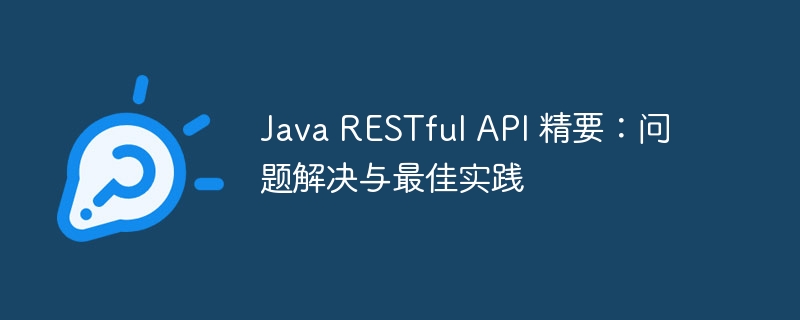Home >Java >javaTutorial >Java RESTful API Essentials: Problem Solving and Best Practices
Java RESTful API Essentials: Problem Solving and Best Practices
- WBOYWBOYWBOYWBOYWBOYWBOYWBOYWBOYWBOYWBOYWBOYWBOYWBOriginal
- 2024-05-08 12:36:02918browse
Three common problems and best practices in Java RESTful API development: Handling API request verification: Use Java framework and annotations to implement custom verification rules. Optimize response time: adopt an object mapper, enable caching, and use asynchronous programming. Ensure API security: Adopt security protocols, implement authentication and authorization, and use security frameworks.

The Essentials of Java RESTful API: Problem Solving and Best Practices
Introduction
RESTful APIs play a vital role in modern application development, they provide a flexible and extensible interface to access server-side data and operations. However, when developing and deploying RESTful APIs, you may encounter various issues. This article will address some common RESTful API issues and provide best practices to improve efficiency and robustness.
Problem 1: Handling API request verification issues
Solution:
Use Java frameworks and libraries (such as Jackson or Gson) to Parse JSON requests and perform data validation.
Implement custom annotations or interceptors to enforce validation rules.
For example, use the @Valid annotation to indicate fields that require data validation.
Problem 2: Optimize response time
Solution:
Use an object mapper (such as Jackson) for fast serialization and reverse Serialize JSON data.
Enable HTTP caching to reduce duplicate requests to the server.
Use asynchronous programming (such as Java CompletableFutures) to process requests in parallel.
Problem 3: Ensure API security
Solution:
Use a secure protocol (such as HTTPS).
Implement authentication and authorization mechanisms (such as JSON Web Tokens).
Use a security framework (such as Spring Security) to deal with common security threats.
Practical Case: Validating API Requests
import javax.validation.Valid;
@RestController
@RequestMapping("/api/v1/users")
public class UserController {
@PostMapping
public User createUser(@Valid @RequestBody User user) {
// ... 保存用户并返回响应
}
}In this example, the @Valid annotation ensures that the data in the request body is verified before saving the user.
Best Practices
- Follow RESTful principles: Follow REST principles such as unified interface, statelessness and cacheability.
- Use version control: Maintain versions of the API to support backward compatibility and new features.
- Handle errors well: Provide clear and helpful error messages and use appropriate HTTP status codes.
- Conduct unit tests: Write unit tests to verify proper functioning and error handling of the API.
- Follow coding standards: Use a consistent coding style and follow Java coding best practices.
The above is the detailed content of Java RESTful API Essentials: Problem Solving and Best Practices. For more information, please follow other related articles on the PHP Chinese website!
Related articles
See more- Customized Spring Security permission control management example in java (Practical)
- How to quickly implement Spring security permission authentication management (detailed steps)
- Testing Spring Security authentication using JUnit
- How to use Java to develop a single sign-on system based on Spring Security OAuth2

